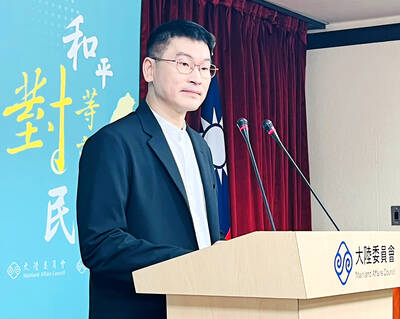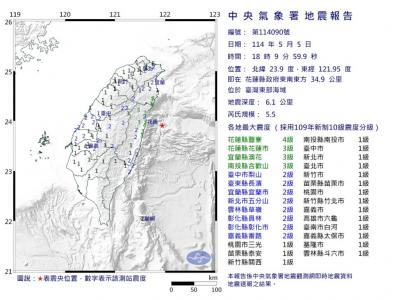President Ma Ying-jeou (馬英九) yesterday lauded the Coast Guard Administration (CGA) and the Ministry of National Defense for escorting Taiwanese fishermen to the Diaoyutai Islands (釣魚台) on Tuesday, calling the move a declaration of Taiwan’s sovereignty over the islands.
“Under the escort of coast guard vessels, our fishermen sailed close to the Diaoyutais. Taiwanese fishermen declared to the world that the Diaoyutais are part of the territory of the Republic of China [ROC], and have been occupied by Japan for 117 years,” he said at a luncheon with members of the Combined Logistics Command.
To assert the nation’s sovereignty over the islands, 75 Taiwanese vessels sailed near the Diaoyutais early on Tuesday, escorted by 10 CGA ships. When Japanese patrol boats sprayed the Taiwanese fishing boats with water to drive them away, Taiwanese coast guard vessels retaliated with their own water cannons, resulting in a tense standoff.

Photo: CNA
Given the rough sea conditions, the Taiwanese boats started returning to the fishing port of Nanfangao (南方澳) in Yilan County several hours later, with CGA vessels remaining about 7km from the Diaoyutais to see that all fishing boats left the area safely.
Ma yesterday said the coast guard played a crucial role in safeguarding the safety of Taiwanese fishermen and said he had called CGA head Wang Jinn-wang (王進旺) to convey his gratitude for the agency’s assistance.
“We will not put our military on the front line, but they will be well-prepared to take full control of the situation in the Diaoyutais,” he said.
Ma said the island chain has been the fishing grounds of Taiwanese fishermen for decades and the government fully supports fishermen’s move to protect their right to fish in those waters.
In related news, the CGA dismissed a media report that national security authorities had negotiated beforehand with Japan and China, asking Japan not to be too provocative toward the Taiwanese boats and for China not to send ships to the area.
The negotiation was to “ensure that everything followed the script,” the Chinese-language China Times quoted an unnamed senior official as saying.
Lee Mao-jung (李茂榮), deputy director of the CGA’s Maritime Patrol Directorate-General, who led the CGA flotilla that escorted the protest, said it was impossible to simulate the confrontation, which included several dangerous actions such as the firing of water cannons and the release of smoke.
CGA Deputy Minister Cheng Chang-Hsiung (鄭樟雄) said the agency did inform Japanese authorities of the fishermen’s protest in advance and asked them not to interfere or to judge the situation wrongly.
They were told that “we will have countermeasures to any action they take,” Cheng said.
Additional reporting by CNA

An essay competition jointly organized by a local writing society and a publisher affiliated with the Chinese Communist Party (CCP) might have contravened the Act Governing Relations Between the People of the Taiwan Area and the Mainland Area (臺灣地區與大陸地區人民關係條例), the Mainland Affairs Council (MAC) said on Thursday. “In this case, the partner organization is clearly an agency under the CCP’s Fujian Provincial Committee,” MAC Deputy Minister and spokesperson Liang Wen-chieh (梁文傑) said at a news briefing in Taipei. “It also involves bringing Taiwanese students to China with all-expenses-paid arrangements to attend award ceremonies and camps,” Liang said. Those two “characteristics” are typically sufficient

A magnitude 5.9 earthquake that struck about 33km off the coast of Hualien City was the "main shock" in a series of quakes in the area, with aftershocks expected over the next three days, the Central Weather Administration (CWA) said yesterday. Prior to the magnitude 5.9 quake shaking most of Taiwan at 6:53pm yesterday, six other earthquakes stronger than a magnitude of 4, starting with a magnitude 5.5 quake at 6:09pm, occurred in the area. CWA Seismological Center Director Wu Chien-fu (吳健富) confirmed that the quakes were all part of the same series and that the magnitude 5.5 temblor was

The brilliant blue waters, thick foliage and bucolic atmosphere on this seemingly idyllic archipelago deep in the Pacific Ocean belie the key role it now plays in a titanic geopolitical struggle. Palau is again on the front line as China, and the US and its allies prepare their forces in an intensifying contest for control over the Asia-Pacific region. The democratic nation of just 17,000 people hosts US-controlled airstrips and soon-to-be-completed radar installations that the US military describes as “critical” to monitoring vast swathes of water and airspace. It is also a key piece of the second island chain, a string of

The Central Weather Administration has issued a heat alert for southeastern Taiwan, warning of temperatures as high as 36°C today, while alerting some coastal areas of strong winds later in the day. Kaohsiung’s Neimen District (內門) and Pingtung County’s Neipu Township (內埔) are under an orange heat alert, which warns of temperatures as high as 36°C for three consecutive days, the CWA said, citing southwest winds. The heat would also extend to Tainan’s Nansi (楠西) and Yujing (玉井) districts, as well as Pingtung’s Gaoshu (高樹), Yanpu (鹽埔) and Majia (瑪家) townships, it said, forecasting highs of up to 36°C in those areas